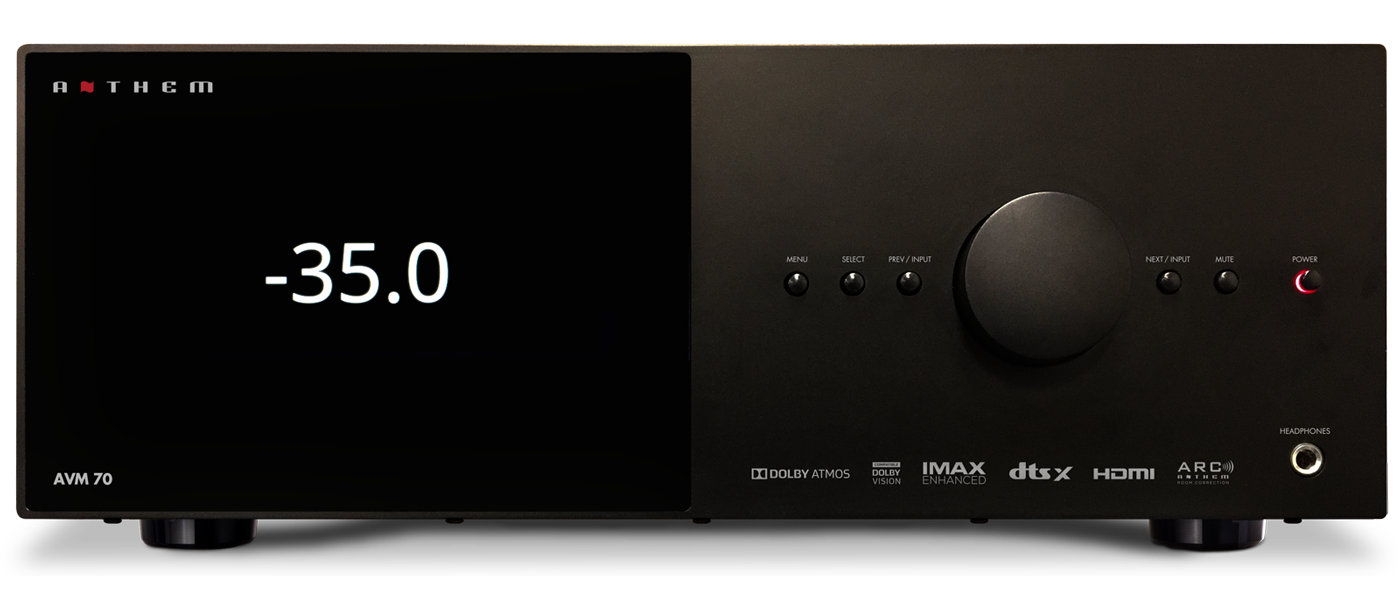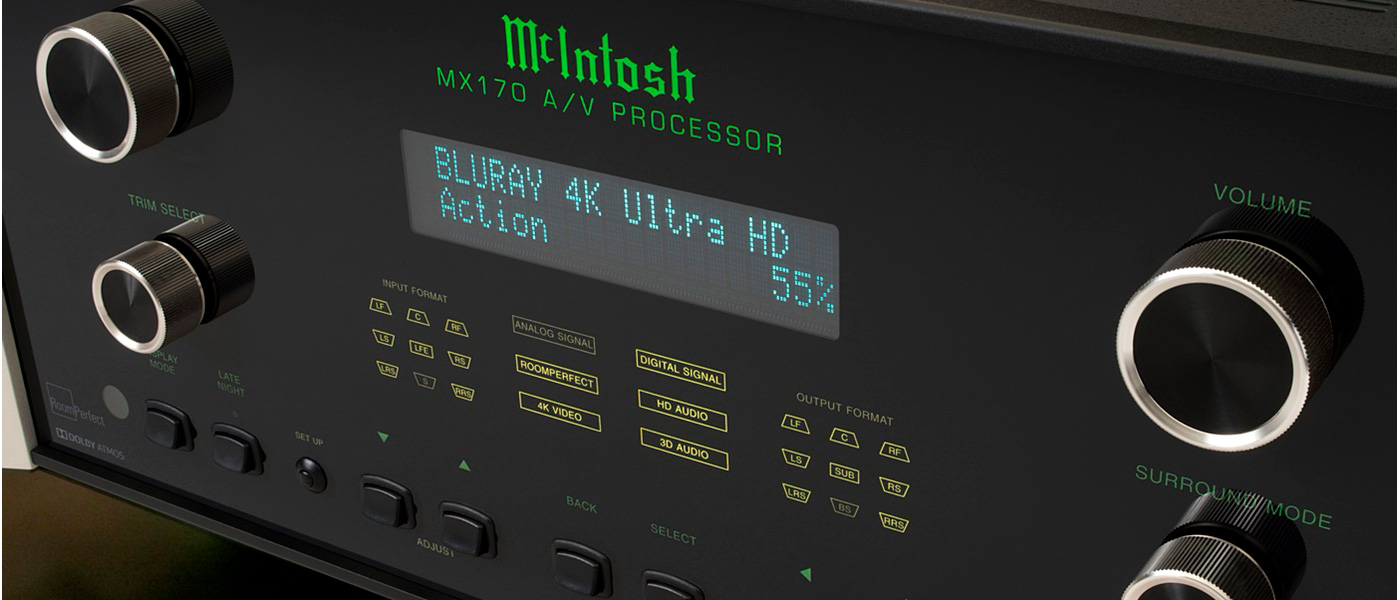
The accompanying MC257 7-Channel solid-state power amp is also beyond reproach in terms of build quality and delivers with 200-watts per channel of clean power.
I found the McIntosh MX170 to be a top performer in all areas demanded from a surround processor. This would be digital surround sound of course but also the analog audio performance, even in bypass mode with two channels driven. The MX170 includes RoomPerfect which is a cutting-edge room-correction package. It also had a pristine video pass-through with 4K and HDR functionality.
Secrets Sponsor
Included in my review is the amazingly powerful MC257 7-channel amp that features the classic McIntosh analog power meter and also impresses with loads of dynamic headroom.
McIntosh MX170 Surround Sound Processor and MC257 7-Channel Power Amplifier
- All current and legacy surround modes supported
- 4K and 3D video passthrough with full HDR support
- RoomPerfect room correction
- Surprisingly-good phono stage
- Powerful and clean-sounding multi-channel solid-state amplifier
- Custom installation control ready (Savant, Control 4, Elan, Crestron, and AMX)
McIntosh Labs is an iconic American brand. If you are like me, you think of McIntosh in the same vein as Harley-Davidson, Apple, Klipsch, etc. You get the idea. These brands are pure Americana and are widely sought after around the globe. So it was with little hesitation that I agreed to review their new home theater-focused products – the MX170 Surround Sound Processor and the MC257 7-Channel Power Amplifier.
These products, like all McIntosh products, share the company’s classic look with the glass faceplates, blue backlighting, old-timey toggle switches, and mid-century-styled knurled knobs. The amplifier even sports a trio of the beloved analog power meters. Both products are built like tanks and should provide a lifetime of enjoyment. Please read my below review for the full run-down!
McIntosh MX170 A/V Processor
Processing:
– Audio: Auro 3D, Dolby Atmos, DTS:X, Neo X, Dolby Surround, DTS-HD Master Audio, DTS-ES 6.1 Discrete, DTS-ES 6.1 Matrix, DTS 5.1
– Video: High Dynamic Range (HDR) – Dolby Vision, HDR10 and HLG
Correction:
RoomPerfectTM Room Correction
Inputs:
HDMI – 8, Multi-Channel Unbalanced – 1 (7.1), Analog RCA – 6 (Includes 1 MM Phono in), SPDIF Coax – 3, Toslink – 4, USB – 2Type A 1 Type B
Outputs:
HDMI – 4, 15.1 Pre-amp output (Balanced), Zone 2 Stereo – 1 (Unbalanced RCA), Zone 2 SPDIF Coax – 1, Auxiliary (Balanced) – 4
Third-Party Control:
RS232, Web IP, IR Input
Operation:
2-Zone Operation
Signal to Noise (MFR):
Phono is 86dB below rated output (A-Weighted), High Level is 96dB below rated output (A-Weighted)
Frequency Response (MFR):
20Hz-20kHz ± 0.5 dB
Total Harmonic Distortion (MFR):
0.005%
Dimensions:
17-1/2”W x 19-1/2”D x 7-5/8”H
Weight:
30.0 Pounds
MSRP:
$15,500.00 (USD)
McIntosh MC257 7-Channel Solid State Power Amplifier
Design:
7-Channel Solid-State Power Amplifier
Power Output:
– 3 Front Channels only: 250W @ 4 or 8 Ohms
– All 7 Channels: 200W @ 4 or 8 Ohms
THD (MFR):
0.005%
Frequency Response:
– +0, -0.25dB from 20Hz to 20,000Hz
– +0, -3dB from 10Hz to 100,000Hz
Input Impedance:
Not Stated
Damping Factor:
– +0, -0.25dB from 20Hz to 20,000Hz
– +0, -3dB from 10Hz to 100,000Hz
Dimensions:
17-1/2”W x 21”D x 9-7/16”H
Weight:
95 lbs
MSRP:
$10,000.00 (USD)
Website:
Company Directory:
SECRETS Tags:
McIntosh, RoomPerfect, Power Meters, Surround Processor, Multi-channel amplifier, Phono, Reveiver and Processor Review, Review 2020
I’ll start with a brief overview of the processor first. The MX170 is McIntosh’s top of the line surround processor. In typical McIntosh fashion, this product is about as comprehensive as I can imagine.
In my view (and a major reason why I wanted to review it), the biggest selling point is its inclusion of the RoomPerfectTM room correction system. According to McIntosh, “[It is] room correction technology that will measure and adjust the audio output to compensate for the specific acoustic properties of your room and make every seat in the house the best seat in the house.” RoomPerfectTM is quite unique among competing systems. It begins by measuring the sweet spot and then you measure random locations in the room until the system tells you it has enough data to adequately model the room and then calibrate your system to the room.
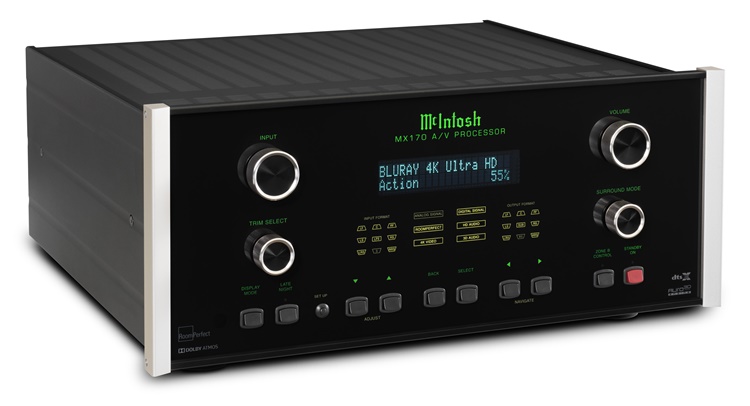
The unit came with a calibrated electret condenser mic, a balanced mic cable, and a boom mic stand. I will discuss this system in more detail in the sections to follow.
Of course, the MX170 can decode all the modern and legacy surround formats and has an almost ridiculously-comprehensive suite of hookup options. It can output up to 16 channels (all by way of balanced XLR outs (no unbalanced outputs). I have a pretty modest 5.2.2 set up. So all the extra channels were not needed in my theater. The MX170 worked well despite that it only calibrates a single LFE channel via the mono subwoofer out in its processing and I needed to work around this limitation in setting up and using the product. McIntosh pointed out that the unit can handle and individually calibrate LFE sent to the front main speakers, the rear main speakers, front stereo subwoofers, or rear stereo subwoofers. Since my dual subwoofer placement is asymmetric, these possibilities were of no use to me.
The MX170 has 8 HDMI inputs and 4 HDMI outputs. Unfortunately, it was not capable of sending signals to multiple displays simultaneously because this system was originally designed to send four signals to a single display for split-screen capabilities. So this limitation presented as another workaround opportunity for my system which features both a direct-view display and a front projector.
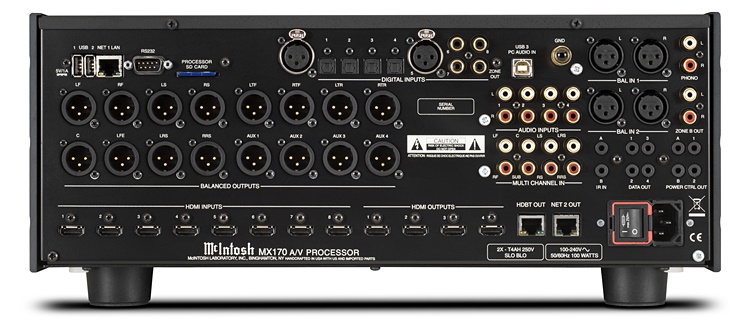
This processor is more appropriately intended to be the centerpiece of a large custom-installed system. This begins with its capability to be controlled by a third-party integration system such as Crestron, Control4, etc. So you will typically find this unit in significant custom-installed systems and not so much in my modest living room set up.
The unit comes with an IR remote but because of its native intent to be part of a custom-installed system, the processor is best controlled by a web interface. Once connected to your home network, you can control it from your phone, tablet, or computer by entering the static IP address that is indicated on the front display. This is how we controlled the unit around the Clements household during the review period.
As part of this high-end pedigree, the MX170 has cutting-edge HDMI processors such that all HDMI inputs and outputs can pass full 4K HDR signals in a 4:4:4 color space. The unit even features an HDBaseT output to support long runs from the processor to your projector.
McIntosh did not forget about the two-channel lovers out there and the MX170 has a full suite of analog and digital inputs for two-channel listening. They even included a very nice sounding MM phono input! The digital inputs can accept PCM signals up to 24-bit/192kHz.

McIntosh also sent along a newly-released 7-channel amplifier for the review, the MC257. This thing is a beast! It clocks in at 95 pounds and simultaneously puts out 200 clean watts into each of its seven channels. This is supported by the McIntosh proprietary Dynamic Power Manager® (DPM) technology.
McIntosh even claims to have increased filter capacity by 20% over prior models which leads to an amazing 3.3dB of dynamic headroom.
This amp has three large power meters on the front panel. These are for the LCR channels only. Of course, I loved the meters and they are a fun novelty to showcase your system.
The heat sinks are massive and feature the “Mc” monogram look which I also liked! The heat sinks obviate the need for any kind of forced-air cooling.
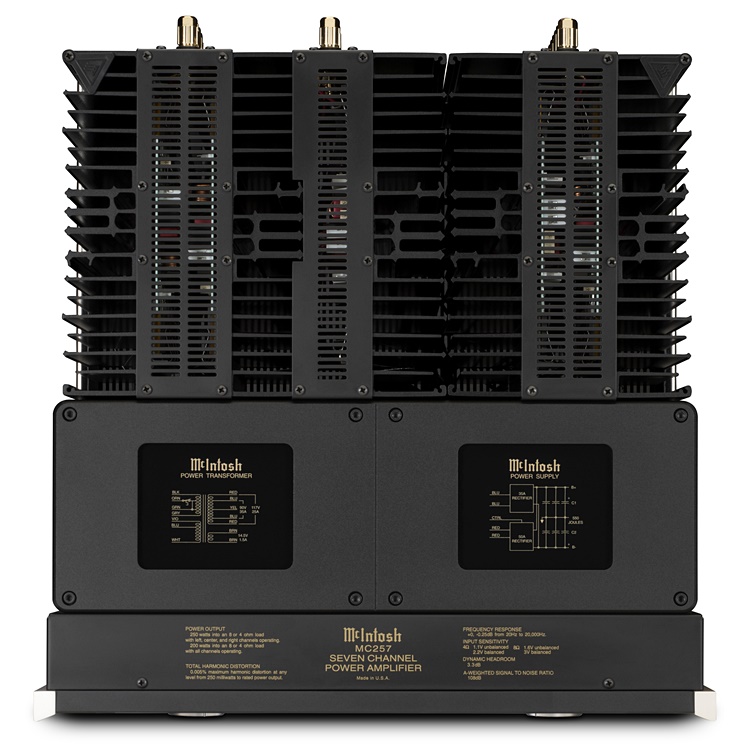
McIntosh also includes all of their most sophisticated protection circuitry in the MC257. The amplifier is modular in design with inputs along the bottom and high-quality binding posts on the amp cards that are situated vertically above.
All this tech is supported by a sleek chrome plinth. The whole package: the front panel, the meters, the heat sinks, the classic McIntosh look, and feel, along with the unit’s amazing performance were very comely and seductive.
The setup was pretty typical for my system. It is important to note that these components come in some quite large boxes. So they barely fit in the cabinet I use for these things. I suggest you verify if they will fit in your rack before placing your order. At 21” deep, the amplifier in particular barely fit with the cabinet doors closed.
I placed the MX170 in the cabinet first and connected everything. I initially connected my front projector to the HDMI Out 1 and my direct view display to HDMI Out 2 believing that the unit would send the same signal to both displays like my reference processor. It did not. That meant that, during the review period, I needed to manually unplug the one I wasn’t using and plug in the one I wanted to use. It was a hassle. McIntosh reps told me that most installers use an outboard HDMI splitter. I used to have one but it was way before 4K became a thing. So I just manually switched them out as needed.
This is a good time to mention this unit worked best for me when controlled by the McIntosh app. So be sure you connect the unit to your home network by way of the Ethernet connection. (The MX170 does not have WiFi.) The app provides complete control of the unit and is best accessed on a tablet or laptop because the greater screen real estate allowed a better interface than my phone though I did use my phone for input switching and volume control in casual settings.

I then hooked up the MC257 amplifier. The MX170 amp only has balanced outputs so that was the connection used. You also need to install a trigger if you want the processor to control on/off of the amp as well as remote on/off of the front meter back-lighting. Since this arrangement requires separate signals for power and illumination toggles, you will need to use a stereo mini plug for the trigger. I am not sure how you would control the meters’ backlights with a different brand of processor.
At this point, I was ready to calibrate the audio with the RoomPerfect system. The initial review unit presented two issues that caused me to request and receive a replacement: first, the IR remote did not work (it was an issue internal to the processor) and, second, there was an issue with the mic cable. So I requested a replacement which McIntosh sent after the new unit passed a full QA check-up. This afforded me the opportunity to use the system without calibration for several weeks and I will describe my listening impressions in the ensuing sections of this review.
Once I had the replacement in, I was ready for calibration. This time it went off without a hitch. As I mentioned earlier, RoomPerfect is different from other systems in that it has you take the first measurements at the sweet spot and then place the mic in different random locations repeatedly until the system alerts you it has collected enough data to faithfully calibrate to your room/system. The first time I ran it, I really wanted to meet the spirit of randomized locations. So I tossed a bottle cap in the air (eyes closed) and then placed the mic where the cap landed. In subsequent calibrations, I just put the mic in various listening positions. I did not detect any major differences in the results either way.
Now that I had everything installed and calibrated, I was ready to sit down for some critical evaluation!
As described above, I wound up using the system for a few weeks until the new processor came in. What that meant is I used it in an un-calibrated state while waiting for the replacement. This was a very interesting exercise because it gave me a window into the processor’s native performance. What I heard at this time was more than promising, it was in fact excellent sounding.
This actually came as a bit of a surprise because I could not figure out how to set speaker distances in the menu outside of it being an intermediate step in the calibration process. So, since I was not able to engage the calibration process with the original unit, I was out of luck to make this adjustment until the replacement was received. They remained at default during this initial phase of the evaluation period. Another surprising thing was that the MX170 did not have a routine to send pink noise to each channel so the channel balances could be manually adjusted. (McIntosh pointed out that “speaker playback levels can be measured in the setup menu under Verify Speakers which uses Pink noise” which is sort of correct but this was an interim step in the calibration that is intended to verify all speakers are connected and to the correct channel. It was not for setting channel balance.)
You can tweak channel balance in the MX170 by way of channel trims that you can adjust on the fly but then they revert to 0 dB when you cycle the power. Speaker level offsets may be adjusted in the setup menu under Channel Gain. Gains may be set uniquely for Dolby/DTS, Auro, or Room Perfect. Clicking on the save tab will store all settings.
That being said, I do need to let you know that the straight-up un-calibrated sound of the MX170 was incredibly clean and dynamic. The hardware engineering and execution was obviously of a very high order. The sound was nothing short of scintillating!


Part of the sound was of course the MC257 power amp. My impression was that the dynamic sound from the processor was cleanly passed by the amplifier and the extra headroom played its role in upholding that dynamic quality. This was particularly apparent when enjoying an action film that presented a great deal of macro dynamics. The McIntosh combo really shone with this type of program material.
I was able to install the replacement MX170 after about four weeks of using the original unit. Calibrating it was a breeze at this point. The RoomPerfect system included the quality microphone, a working mic cable, and a solid boom mic stand. As mentioned earlier, I originally calibrated by way of truly random mic positions. That sounded very balanced with excellent presence. I later re-ran the calibration by placing the mic in various listening positions at ear height to see if this improved results and the fact of the matter is that I did not hear a major difference with either process.
A note on mic placement during calibration: McIntosh indicated that the mic could be placed randomly not only in the horizontal dimension but also in the vertical dimension. You just don’t want to get too cute with it and you should keep the mic placement between the speakers and not too close to a boundary. Makes sense to me.

A note on the HDMI interface. The MX170 passed video with no apparent degradation of the signal and 4K movies looked as good as they ever have on my system, even besting my Arcam AV860 in the process. This is a significant claim on my part as the Arcam is known to have very high-quality HDMI switching.
Besides that I needed to physically switch the output when changing from the front view display to the projector, I also had issues with the HDMI outs, particularly with the Roku. There was an apparent sync issue every time we switched to the Roku that was cured only by unplugging the HDMI from the Roku, waiting a few seconds, and then reconnecting it. Our Roku is easily accessible so doing this wasn’t the biggest issue in the world, but it kind of went against the unit’s rai·son d’ê·tre.
Let me explain. I spoke with McIntosh representatives about a number of the unit’s operational quirks and they explained how the MX170 was intended for cost-no-object custom installations. You know, the kind of lusty drool-worthy systems that have banks upon banks of monoblock amplifiers and speakers all over tarnation. Certainly, your installer would set it up and program everything so you could operate it using your custom control system. If you had a problem, the installer could access remotely and make certain settings changes. This was the plan and I get that. But I think if I sank hundreds of thousands of dollars into a system like they described, then I would be fairly annoyed that I would still have to unplug and replug a commonly-used component every time I wanted to use it. So I hope McIntosh will address this issue with a future firmware update.
The various operational quirks aside, I do want people to understand that I am the type of person who gets their system set up and dialed in, and then I just use it. I don’t fiddle with the settings very much. In this context, the McIntosh combo was stellar. Once set up and calibrated, I enjoyed some of the most luxurious sound I have ever experienced in my theater.
It had an amazing surround bubble that put me in the center of the action. This soundscape featured pinpoint imaging of all the discrete effects. The overall clarity, dynamic punch, and low distortion of the sound were above reproach. This led to me devouring 4K Blu-Rays of all kinds during the review period. I do regret not bench testing the units. It was just that I had these products in during the early stages of the Cornovirus Pandemic and so many other things interfered with my review schedules, I just had to ship them back before I could test.
If I had tested them, I think they would have been some excellent results and quite possibly among the best in their class.
One thing of note on the audio processing. The MX170 will only apply Dolby post-processing to Dolby input signals. If you have an old DTS track, then you can post-process with DTS: X but not Dolby. McIntosh claimed this was due to Dolby’s strict licensing requirements, but a vast majority of surround sound processors do not have this constraint.


Let’s talk about the MC257 amplifier for a second. This amp is a bad mother that can crank out some serious wattage. It is rated at 200 wpc RMS continuous with all 7 channels driven into 8 Ohm loads. This is serious firepower. And with McIntosh, I am sure the amp exceeds those claims. Remember also that the amp has a claimed 3.3 dB headroom. This means the MC257 can be the engine for just about any home theater regardless of the sensitivity of the speakers, the size of the room, or any other factor I can think of. The honest truth is that I have been enjoying a ~7 wpc 300B tube-based amplifier when listening to two-channel music lately and it just reminds me how much overkill 200 wpc actually is.
But that’s not the point of 200 watts. The point is what I mentioned earlier: the greater power reserves mean unmitigated dynamics. Movie soundtracks can have a lot of dynamic contrasts and this is where the 200 watts shows itself. Also, the additional reserve power means that you don’t have to worry about over-driving your amp, thereby damaging your speakers. It gives you peace of mind as you sit back and enjoy the show.
I do want to make special mention of the built-in MM phono stage. I have used many a phono preamp in my days. These range from ones built into a vintage receiver up to full-on uber-engineered phono preamps. The mighty McIntosh’s implementation can go toe-to-toe with any of them. I am so pleased that McIntosh took the extra step to include this feature for their customers. It provides just one more avenue to really enjoy your home entertainment system.
The McIntosh MX170 Surround Sound Processor and MC257 7-Channel Power Amplifier have a great deal of flexibility and power. The processor employs RoomPerfect room correction and both pieces used together provide a highly elevated performance.
- Reference-level video switching
- Audio characterized by breathtaking clarity and dynamics
- World-class surround effects especially with discrete effects
- Top-quality MM phono stage
- Built like two little tanks
- Simultaneous HDMI output to multiple displays
- Improved user interface with more fine-tuning capability
- Ability to calibrate multiple subwoofers irrespective of their room placements
- Updated HDMI firmware to avoid syncing issues
I hate to admit that the McIntosh combo was a mixed bag. I mean, McIntosh is a mighty brand with an iconic image that is pure Americana. I had hoped for a better user interface, more accessible fine-tuning features, an HDMI interface that would send simultaneous signals to more than one display, etc.
Little of that matters when you are a purist at heart. That would be me. I just want great audio and video so I can enjoy the show while being as immersed as possible. The McIntosh combo checked all the performance-related boxes when it came to signal integrity and immersion. Also, clarity and dynamics were off the charts.

I was particularly smitten by the MC257 power amp. This brawny beast was excellent in every facet of its design and performance. I seriously thought about buying it but I was vetoed by my spouse for budgetary reasons. (I had just recently bought a new 7-channel amp.)
Secrets Sponsor
The last word on this system is that I do recommend both pieces to anybody who is either a power-user or wants a custom-installed system beyond reproach. The performance qualities are top of the line in my experience.


